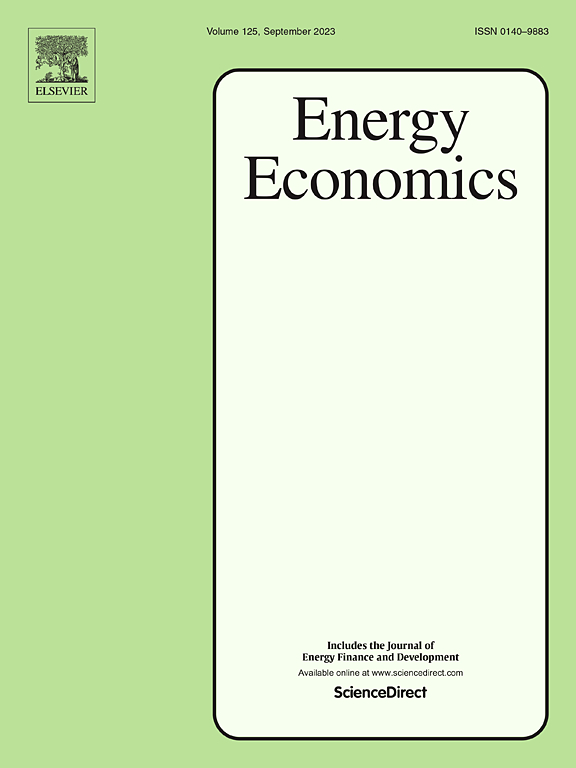Photovoltaic expansion and ecological trade-offs: Short-term vegetation loss and rapid recovery
IF 14.2
2区 经济学
Q1 ECONOMICS
引用次数: 0
Abstract
To address climate change and facilitate the low-carbon energy transition, photovoltaic (PV) capacity has rapidly expanded, raising concerns about the displacement of forests, grasslands, and cropland. We examine the ecological consequences of this expansion by analyzing high-resolution spatial data on PV plants in China (2010–2022) matched with 250 m resolution NDVI observations. Using a staggered difference in differences framework, we find that: (i) PV installation significantly reduces local vegetation cover in the short run, largely due to site clearing; (ii) this effect recedes over time, becoming statistically insignificant three to four years after installation, and in some regions even turning modestly positive owing to decreased evapotranspiration; (iii) heterogeneity analyses show pronounced damage in humid areas, while semi-arid and desert regions exhibit minimal or positive effects; (iv) stricter ecological management and judicious siting mitigate or eliminate these losses, such as in national key ecological function areas; and (v) no evidence emerges of negative spillovers on surrounding vegetation or of worsened local PM10. Furthermore, utilizing global photovoltaic installation distribution data and NDVI data at 500 m resolution, similar negative impacts on vegetation greenness are observed in PV installations across 34 lesser-developed economies, including India, Brazil, Vietnam, and South Africa. In sum, optimal site selection and strengthened ecological safeguards are needed to balance large-scale PV deployment with ecological protection.
光伏扩张与生态权衡:短期植被损失与快速恢复
为了应对气候变化和促进低碳能源转型,光伏发电(PV)容量迅速扩大,引起了人们对森林、草原和农田被取代的担忧。我们通过分析中国光伏电站(2010-2022年)的高分辨率空间数据与250米分辨率NDVI观测结果相匹配,研究了这种扩张的生态后果。使用交错差异框架,我们发现:(i)光伏安装在短期内显着减少了当地的植被覆盖,主要是由于场地清理;随着时间的推移,这种影响逐渐减弱,在安装装置三至四年后,在统计上变得微不足道,在一些地区,由于蒸散量减少,甚至转为适度的正效应;(iii)异质性分析显示湿润地区受到明显损害,而半干旱和沙漠地区则受到最小或积极影响;(iv)更严格的生态管理和明智的选址,减轻或消除这些损失,例如在国家重点生态功能区;(v)没有证据表明对周围植被有负面溢出或当地PM10恶化。此外,利用全球光伏安装分布数据和500米分辨率的NDVI数据,在34个欠发达经济体(包括印度、巴西、越南和南非)的光伏安装中观察到类似的植被绿化率负面影响。综上所述,在光伏大规模部署与生态保护之间取得平衡,需要优化选址,加强生态保障。
本文章由计算机程序翻译,如有差异,请以英文原文为准。
求助全文
约1分钟内获得全文
求助全文
来源期刊

Energy Economics
ECONOMICS-
CiteScore
18.60
自引率
12.50%
发文量
524
期刊介绍:
Energy Economics is a field journal that focuses on energy economics and energy finance. It covers various themes including the exploitation, conversion, and use of energy, markets for energy commodities and derivatives, regulation and taxation, forecasting, environment and climate, international trade, development, and monetary policy. The journal welcomes contributions that utilize diverse methods such as experiments, surveys, econometrics, decomposition, simulation models, equilibrium models, optimization models, and analytical models. It publishes a combination of papers employing different methods to explore a wide range of topics. The journal's replication policy encourages the submission of replication studies, wherein researchers reproduce and extend the key results of original studies while explaining any differences. Energy Economics is indexed and abstracted in several databases including Environmental Abstracts, Fuel and Energy Abstracts, Social Sciences Citation Index, GEOBASE, Social & Behavioral Sciences, Journal of Economic Literature, INSPEC, and more.
 求助内容:
求助内容: 应助结果提醒方式:
应助结果提醒方式:


